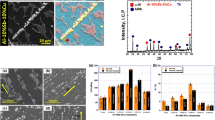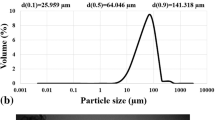Abstract
Ultrafine-grained Cu–5 vol%Al2O3 nanocomposite rods were fabricated by a combination of high-energy mechanical milling of Cu and Al2O3 powders and powder compact extrusion at 300, 500, 700 and 900 °C. The extruded rods were investigated to evaluate microstructures, mechanical properties, fracture behavior and electrical resistivity. It was found that the extrusion temperature has a pronounced effect on Cu grain growth, Al2O3 particle coarsening and particle distribution. High-temperature extrusion leads to directional coarsening of certain grains. As such, a heterogeneous matrix structure of large elongated and equiaxed grains is created, and this unique matrix structure brings beneficial effects in tensile ductility and electrical resistivity. While Al2O3 dispersions in the matrix improve the overall performance of the nanocomposite, an incorrect selection of the extrusion temperature may have detrimental effects on yield strength and resistivity. Tensile fractography investigation shows that the presence of Al2O3 results in failures along grain boundaries. This study also provides a framework for modeling the mechanical and electrical properties of such complex matrix structures. Modeling tools/formulae can be used to predict mechanical/electrical properties via microscopic characteristics and hence can also be used to understand the effect of processing variables.








Similar content being viewed by others
References
Wang F, Li Y, Wang X, Koizumi Y, Kenta Y, Chiba A (2016) In-situ fabrication and characterization of ultrafine structured Cu–TiC composites with high strength and high conductivity by mechanical milling. J Alloys Compd 657:122–132
Zhou DS, Zeng W, Zhang DL (2016) A feasible ultrafine grained Cu matrix composite microstructure for achieving high strength and high electrical conductivity. J Alloys Compd 682:590–593
Ďurišinová K, Ďurišin J, Orolínová M, Ďurišin M, Szabó J (2015) Effect of mechanical milling on nanocrystalline grain stability and properties of Cu–Al2O3 composite prepared by thermo-chemical technique and hot extrusion. J Alloys Compd 618:204–209
Wang F, Li Y, Xie G, Wakoh K, Yamanaka K, Koizumi Y, Chiba A (2016) Investigation on hot deformation behavior of nanoscale TiC-strengthened Cu alloys fabricated by mechanical milling. Mater Sci Eng A 668:1–12
Darling KA, Huskins EL, Schuster BE, Wei Q, Kecskes LJ (2015) Mechanical properties of a high strength Cu–Ta composite at elevated temperature. Mater Sci Eng A 638:322–328
Darling KA, Rajagopalan M, Komarasamy M, Bhatia MA, Hornbuckle BC, Mishra RS, Solanki KN (2016) Extreme creep resistance in a microstructurally stable nanocrystalline alloy. Nature 537(7620):378–381
Hu LX, Li ZM, Wang ED (1999) Influence of extrusion ratio and temperature on microstructure and mechanical properties of 2024 aluminium alloy consolidated from nanocrystalline alloy powders via hot hydrostatic extrusion. Powder Metall 42(2):153–156
Liang GX, Meng QC, Li ZC, Wang ED (1995) Consolidation of nanocrystalline Al–Ti alloy powders synthesized by mechanical alloying. Nanostruct Mater 5(6):673–678
Malow TR, Koch CC (1998) Mechanical properties, ductility, and grain size of nanocrystalline iron produced by mechanical attrition. Metall Mater Trans A 29(9):2285–2295
Nieman GW, Weertman JR, Siegel RW (1991) Mechanical behavior of nanocrystalline Cu and Pd. J Mater Res 6(05):1012–1027
Sanders PG, Eastman JA, Weertman JR (1997) Elastic and tensile behavior of nanocrystalline copper and palladium. Acta Mater 45(10):4019–4025
Zhang DL, Koch CC, Scattergood RO (2009) The role of new particle surfaces in synthesizing bulk nanostructured metallic materials by powder metallurgy. Mater Sci Eng A 516(1):270–275
Zhang DL, Muhktar A, Nadakuduru VN, Raynova S (2009) The possibility of synthesizing bulk nanostructured or ultrafine structured metallic materials by consolidation of powders using high strain powder compact forging. Int J Mater Res 100(12):1720–1726
Botcharova E, Freudenberger J, Schultz L (2006) Mechanical and electrical properties of mechanically alloyed nanocrystalline Cu–Nb alloys. Acta Mater 54(12):3333–3341
Zhou DS, Zhang DL, Kong C, Munroe P, Torrens R (2014) Thermal stability of the nanostructure of mechanically milled Cu–5 vol%Al2O3 nanocomposite powder particles. J Mater Res 29(08):996–1005
Williamson GK, Hall WH (1953) X-ray line broadening from filed aluminium and wolfram. Acta Metall 1(1):22–31
Williamson GK, Smallman RE (1956) III. Dislocation densities in some annealed and cold-worked metals from measurements on the X-ray debye-scherrer spectrum. Philos Mag 1(1):34–46
Stokes AR, Wilson AJC (1944) The diffraction of X-rays by distorted crystal aggregates-I. Proc Phys Soc 56(3):174
Simões S, Calinas R, Vieira M, Vieira M, Ferreira P (2010) In situ TEM study of grain growth in nanocrystalline copper thin films. Nanotechnology 21(14):145701
Smith CS (1948) Grains, Phases, and interfaces: an interpretation of microstructure. Trans AIME 175:15–51
Morris D, Morris M (1991) Microcrystalline or nanocrystalline grain size in two-phase alloys after mechanical alloying. Mater Sci Eng A 134:1418–1421
Manohar P, Ferry M, Chandra T (1998) Five decades of the Zener equation. ISIJ Int 38(9):913–924
Wang YM, Chen MW, Zhou FH, Ma E (2002) High tensile ductility in a nanostructured metal. Nature 419(6910):912–915
Zhang ZH, Topping T, Li Y, Vogt R, Zhou YZ, Haines C, Paras J, Kapoor D, Schoenung JM, Lavernia EJ (2011) Mechanical behavior of ultrafine-grained Al composites reinforced with B4C nanoparticles. Scr Mater 65(8):652–655
Wu XL, Yang MX, Yuan FP, Wu GL, Wei YJ, Huang XX, Zhu YT (2015) Heterogeneous lamella structure unites ultrafine-grain strength with coarse-grain ductility. PNAS 112(47):14501–14505
Ma E, Zhu T (2017) Towards strength–ductility synergy through the design of heterogeneous nanostructures in metals. Mater Today 20(6):323–331
Petch NJ (1953) The cleavage strength of polycrystals. J Iron Steel Inst 174:25–28
Hall EO (1951) The deformation and ageing of mild steel: III discussion of results. Proc Phys Soc B 64(9):747
Meyers MA, Chawla KK (2009) Mechanical behavior of materials. Cambridge University Press, Cambridge
Dieter GE, Bacon D (1988) Mechanical metallurgy. McGraw-Hill, New York
Nadkarni AV (1984) Dispersion strengthened copper: properties and applications. High conductivity copper and aluminum alloys. TMS-AIME, Warrendale, PA
Hansen N, Ralph B (1982) The strain and grain size dependence of the flow stress of copper. Acta Metall 30(2):411–417
Ashby MF (1970) The deformation of plastically non-homogeneous materials. Philos Mag 21(170):399–424
Tang F, Anderson IE, Gnaupel-Herold T, Prask H (2004) Pure Al matrix composites produced by vacuum hot pressing: tensile properties and strengthening mechanisms. Mater Sci Eng A 383(2):362–373
Molotnikov A, Lapovok R, Davies CHJ, Cao W, Estrin Y (2008) Size effect on the tensile strength of fine-grained copper. Scr Mater 59(11):1182–1185
Besterci M (1994) Structure analysis of dispersion strengthening. Scr Metall 30(9):1145–1149
Matthiessen A, Vogt C (1864) On the influence of temperature on the electric conducting-power of alloys. Philos Trans R Soc Lond 154:167–200
Murashkin MY, Sabirov I, Sauvage X, Valiev RZ (2016) Nanostructured Al and Cu alloys with superior strength and electrical conductivity. J Mater Sci 51(1):33–49. https://doi.org/10.1007/s10853-015-9354-9
Andrews PV, West MB, Robeson CR (1969) The effect of grain boundaries on the electrical resistivity of polycrystalline copper and aluminium. Philos Mag 19(161):887–898
McLachlan DS, Blaszkiewicz M, Newnham RE (1990) Electrical resistivity of composites. J Am Ceram Soc 73(8):2187–2203
Sudharshan Phani P, Vishnukanthan V, Sundararajan G (2007) Effect of heat treatment on properties of cold sprayed nanocrystalline copper alumina coatings. Acta Mater 55(14):4741–4751
Schafler E, Steiner G, Korznikova E, Kerber M, Zehetbauer MJ (2005) Lattice defect investigation of ECAP-Cu by means of X-ray line profile analysis, calorimetry and electrical resistometry. Mater Sci Eng A 410:169–173
Acknowledgements
Funding from the China Scholarship Council (CSC) (File No. 2010645006), National Natural Science Foundation of China (Project No. 51271115) and the SJTU-UNSW Strategic Collaboration Fund to support this work is gratefully acknowledged.
Author information
Authors and Affiliations
Corresponding authors
Ethics declarations
Conflict of interest
The authors declare that they have no conflict of interest related to the publication of this paper.
Rights and permissions
About this article
Cite this article
Zhou, D., Geng, H., Zeng, W. et al. Effect of extrusion temperature on microstructure and properties of an ultrafine-grained Cu matrix nanocomposite fabricated by powder compact extrusion. J Mater Sci 53, 5389–5401 (2018). https://doi.org/10.1007/s10853-017-1952-2
Received:
Accepted:
Published:
Issue Date:
DOI: https://doi.org/10.1007/s10853-017-1952-2




